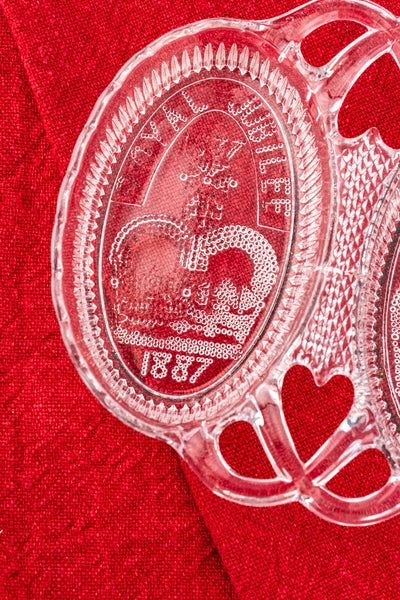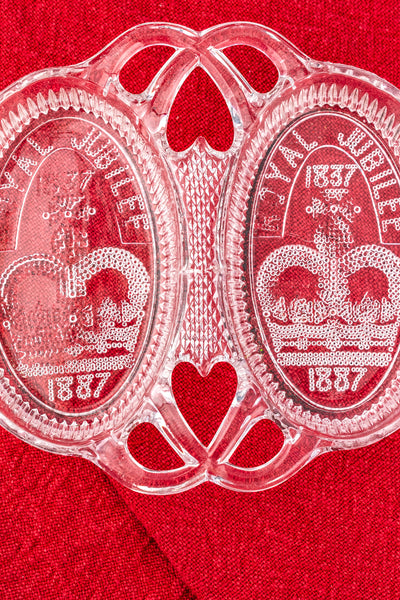Queen Victoria 1887 Golden Jubilee Glass Sweetheart Dish
Queen Victoria 1887 Golden Jubilee Glass Sweetheart Dish
$125.00
Produced in 1887 to commemorate the Golden Jubilee of Queen Victoria's reign, this lovely Divided Glass Dish shimmers with all the lush sentimentality of the Victoria era. With a delicate scalloped edge and romantic handles that intertwine to form a sweet heart on each end, the prominent oval bowls are accented by glass beading on the reverse. Arranged in a scattered pattern on each side, the effect depicts a regal crown nestled within the center, with the words 'Royal Jubilee' and the dates '1837' and '1887'.
A lasting memento from one of the most celebrated royal events in history, this treasure is sure to have held pride of place in a family home for generations. Destined to become a crowning addition to your coronation collection, it promises to glimmer in any setting, whether on display or pressed into service for special occasions.
Strictly one-of-a-kind and subject to prior sale. In very good antique condition. 8"W x 6.25D x 1.25H.
Learn More About Queen Victoria
Queen Victoria was the monarch of the United Kingdom of Great Britain and Ireland from June 20, 1837 until her death on January 22, 1901. From May 1, 1876, she used the additional title of Empress of India.
Victoria was born on May 24, 1819, daughter to Prince Edward, the fourth son of King George III. In a twist of fate, both her father and the King died in 1820, and as possible heir to the throne, 8 month-old Victoria was raised under very strict supervision by her German-born mother Princess Victoria of Saxe-Coburg-Saalfeld. On June 20, 1837, Victoria's uncle King William IV died at the age of 71, and at the very young age of 18, Victoria became Queen. In her diary she wrote, "I was awoke at 6 o'clock by Mamma, who told me the Archbishop of Canterbury and Lord Conyngham were here and wished to see me. I got out of bed and went into my sitting-room (only in my dressing gown) and alone, and saw them. Lord Conyngham then acquainted me that my poor Uncle, the King, was no more, and had expired at 12 minutes past 2 this morning, and consequently that I am Queen."
The United Kingdom was already an established constitutional monarchy, in which the Sovereign held relatively few direct political powers. Privately, Victoria attempted to influence government policy and ministerial appointments. Publicly, she became a national icon, and was identified with strict standards of personal morality.
In an arrangement from birth, Victoria married her first cousin, Prince Albert of Saxe-Coburg and Gotha, in 1840. Their nine children married into royal and noble families across the continent, tying the nations together as family and earning Queen Victoria the nickname "the grandmother of Europe". After Albert's death in 1861, the queen plunged into deep mourning, wore black for the remainder of her life and avoided public appearances. She rarely set foot in London in the following years and her seclusion earned her the name "widow of Windsor". As a result of her seclusion, the monarchy lost favor with many British citizens, but in the latter half of her reign, her popularity recovered.
The 50th anniversary of her reign, her Golden Jubilee, was a time of public celebration. On June 20, 1887, Queen Victoria began her Golden Jubilee celebration by taking her breakfast outdoors under the trees at Frogmore, where her beloved husband Prince Albert had been buried. She then traveled by train from Windsor Castle to Buckingham Palace for a royal banquet that evening. Fifty foreign kings and princes, along with the governing heads of Britain's overseas colonies and dominions, attended. She wrote in her diary: "Had a large family dinner. All the Royalties assembled in the Bow Room, and we dined in the Supper-room, which looked splendid with the buffet covered with the gold plate. The table was a large horseshoe one, with many lights on it. The King of Denmark took me in, and Willy of Greece sat on my other side. The Princes were all in uniform, and the Princesses were all beautifully dressed. Afterwards we went into the Ballroom, where my band played."
Her reign of 63 years and seven months, which until very recently, was the longest of any other British monarch and the longest of any female monarch in history, is still referred to today as the Victorian era. It was a period of industrial, cultural, political, scientific, and military change within the United Kingdom, and was marked by a great expansion of the British Empire.






